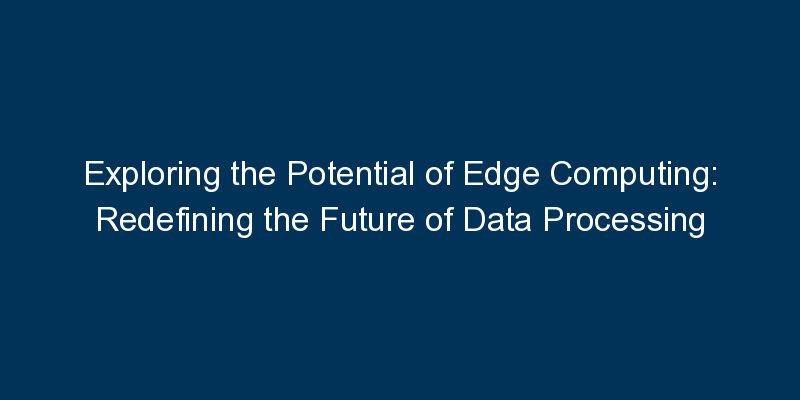Introduction
In the ever-evolving landscape of digital technology, edge computing emerges as a transformative paradigm, reshaping how data is processed and utilized. This blog delves into the potential of edge computing, unraveling its applications, benefits, and the profound impact it is set to have on the future of data processing.
Understanding Edge Computing
Defining Edge Computing
Edge computing is a distributed computing paradigm that brings data processing closer to the source of data generation. Unlike traditional cloud computing, where data is sent to a centralized cloud server, edge computing processes data locally, near the edge devices.
The Edge Ecosystem: Devices and Infrastructure
Edge computing encompasses a diverse ecosystem of devices and infrastructure, including sensors, IoT devices, edge servers, and gateways. This decentralized approach reduces latency, enhances efficiency, and enables real-time processing.
Applications of Edge Computing
IoT and Smart Devices
Edge computing is integral to the Internet of Things (IoT) landscape. By processing data locally, edge devices reduce latency and improve responsiveness, making them ideal for applications like smart homes, industrial IoT, and autonomous vehicles.
Real-Time Analytics and Decision-Making
The ability to process data at the edge facilitates real-time analytics and decision-making. This is crucial for applications in industries such as finance, healthcare, and manufacturing, where split-second decisions can have significant impacts.
Augmented Reality (AR) and Virtual Reality (VR)
Edge computing supports AR and VR applications by processing data locally, providing a seamless and immersive user experience. This is particularly important in gaming, healthcare simulations, and training scenarios.
Advantages of Edge Computing
Reduced Latency and Improved Responsiveness
One of the primary advantages of edge computing is the significant reduction in latency. By processing data locally, edge devices can respond to requests almost instantly, enhancing the overall user experience.
Bandwidth Efficiency
Edge computing reduces the need to transmit large volumes of data to centralized servers, optimizing bandwidth usage. This is particularly beneficial in scenarios where bandwidth is limited or expensive.
Enhanced Security and Privacy
Processing data at the edge can enhance security and privacy. Critical data can be processed locally without the need to transmit sensitive information over networks, reducing the risk of cyber threats.
Challenges and Considerations
Standardization and Interoperability
The lack of standardized practices and interoperability among edge devices poses challenges for seamless integration. Efforts toward standardization are crucial for the widespread adoption and compatibility of edge computing solutions.
Resource Constraints on Edge Devices
Edge devices often have resource constraints in terms of processing power and storage. Optimizing algorithms and considering the trade-off between edge and centralized processing are essential considerations.
Future Trends and Innovations
5G Integration for Enhanced Edge Capabilities
The integration of 5G networks enhances the capabilities of edge computing by providing faster and more reliable connectivity. This trend enables more sophisticated applications and services at the edge.
Edge AI: Merging Edge Computing with Artificial Intelligence
The convergence of edge computing and artificial intelligence (AI), known as edge AI, is a promising trend. This combination allows edge devices to perform complex AI tasks locally, reducing the need for continuous connectivity to centralized servers.
Conclusion
Edge computing represents a pivotal shift in the way data is processed, offering a decentralized approach that aligns with the demands of our interconnected world. As businesses and industries explore the potential of edge computing, they stand to gain unprecedented advantages in terms of efficiency, responsiveness, and real-time decision-making.
The exploration of edge computing is not merely a technological trend; it is a fundamental reimagining of how we leverage data. By embracing the potential of edge computing, industries can unlock new possibilities, redefine user experiences, and pave the way for a future where the edge is at the forefront of data processing innovation.

















Comments